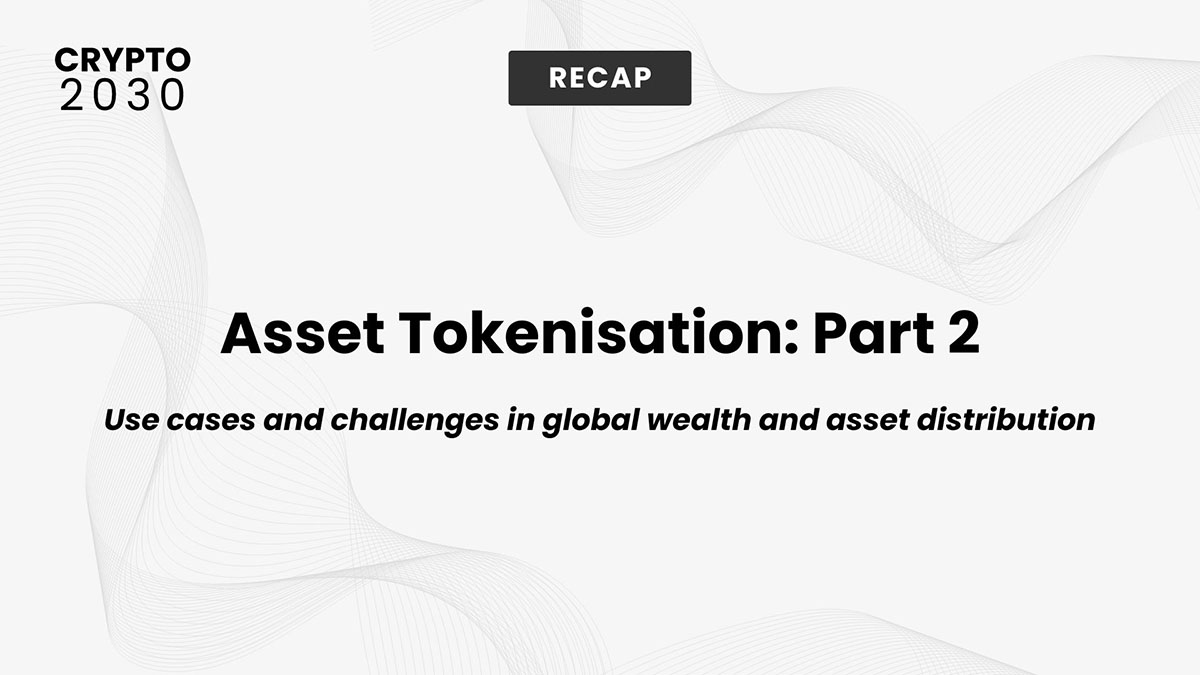This is a continuation of our series on asset tokenisation, exploring its potential to revolutionise investment landscapes. In part 1, we introduced the concept of asset tokenisation and explained how it works. If you missed it, go back and check it out Use Cases and Challenges of Asset Tokenisation in Global Wealth and Asset Distribution (Part 1 of 3) for an overview of what asset tokenisation is and why it matters.

Now, let's dive into the key challenges of asset tokenisation, a crucial step in understanding its potential and preparing for its future growth.
Key challenges of Asset Tokenisation
Regulations
The potential size of the tokenisation market, particularly for real world assets, is enormous, with our panellists quoting figures in the billions of dollars. This is because as long as regulations and policies are met by the relevant stakeholders, any number of large and expensive assets could be tokenised. While the benefits and potential of asset tokenisation seem promising, our panellists agreed that for tokenisation to enjoy mass adoption, there are underlying challenges.
A key obstacle to the widespread adoption of asset tokenisation is regulatory compliance. In most countries, there are no set laws surrounding asset tokenisation and distribution. However, Switzerland’s advanced DLT (Distributed Ledger Technology) laws serve as a positive sign that these laws could eventually become commonplace and serve as a model for other countries.
In essence, DLT laws regulate decentralised technology by protecting both investors and consumers to balance their needs and requirements. All companies, organisations, and individuals must adhere to the laws. The DLT laws strictly define what counts as an electronic record (such as for fungible and non-fungible tokens), and introduces a framework for using those records. Companies must follow this framework to provide information about their tokenisation process for greater transparency. The DLT law also offers companies with legal solutions in the event of bankruptcy, allowing companies to legally separate their crypto assets from their fiat assets on balance sheets.
Bonart Mati, Chief Growth Officer at Obligate, shared that Obligate leverages Switzerland's advanced DLT laws to innovate in the realm of financial securities. Instead of tokenising existing bonds or securities, Obligate utilises these laws to issue bonds directly on the blockchain from the onset.
This approach means that right from their inception, these bonds are designed as securities within the blockchain framework. These blockchain-native bonds can then be traded by investors, making use of the legal and technological framework provided by the DLT law to ensure clarity, security, and compliance in the digital asset space. The Swiss DLT laws offer a promising solution to issues with transparency and reliability in the asset tokenisation space.
Secondary Markets
Another challenge is the creation of a secondary market for tokens, a necessary step for providing liquidity and scaling asset tokenisation. Our panellists highlighted that while tokenising real-world assets has the potential to positively revolutionise real estate and stock markets, the absence of a fully developed secondary market where these tokens can be freely traded remains a challenge. Secondary markets are crucial for the continued trade of tokenised assets, allowing tokens to be traded between users and customers.
The current lack of secondary markets not only impacts liquidity but also the broader adoption of tokenised assets. Despite the existence of platforms like Taurus (which have the necessary licences for secondary trading) and the presence of a regulatory framework like the Swiss DLT, the system required for seamless secondary trading is still in its beginning phases. Addressing this challenge is crucial for the tokenisation of assets to reach its full potential, enabling the free flow of digital assets in a regulated and secure manner.
If the challenges around widespread adoption of asset tokenisation can be effectively remedied, the number of use cases are countless. Our panellists presented use cases in tokenising the stock market, real estate, and even large-scale events such as concerts and car racing.
Coming Up:
This section is part 2 of a 3 part recap about our “Asset Tokenisation” panel at CRYPTO2030.
In this section, we've outlined the key challenges of asset tokenisation, focusing on regulatory compliance and the creation of secondary markets.
While these hurdles exist, the potential for tokenisation is immense, and use cases are abound. In the next part of this series, we'll dive into these promising use cases and outline the steps to developing a successful tokenization strategy. Stay tuned!
Meet the experts behind our "Web3 Governance" panel
At CRYPTO2030, the brightest and most innovative minds in Web3 came together to exchange ideas and propel the advancement of the Web3 space.
Follow our panellists to stay up-to-date on what they are working on:






